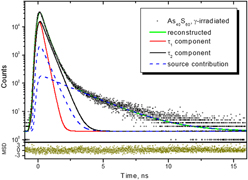Crossref Citations
This article has been cited by the following publications. This list is generated based on data provided by
Crossref.
Shpotyuk, Ya.
Ingram, A.
and
Shpotyuk, O.
2016.
PAL spectroscopy of rare-earth doped Ga–Ge–Te/Se glasses.
Journal of Physics and Chemistry of Solids,
Vol. 91,
Issue. ,
p.
76.
Novak, Spencer
Singh, Vivek
Monmeyran, Corentin
Ingram, Adam
Han, Zhaohong
Lin, Hongtao
Borodinov, Nikolay
Patel, Neil
Du, Qingyang
Hu, Juejun
Luzinov, Igor
Golovchak, Roman
Agarwal, Anuradha
and
Richardson, Kathleen
2016.
Effect of Gamma Exposure on Chalcogenide Glass Films for Microphotonic Devices.
p.
1.
Shpotyuk, Oleh
Ingram, Adam
Filipecki, Jacek
Bujňáková, Zdenka
and
Baláž, Peter
2016.
Positron annihilation lifetime study of atomic imperfections in nanostructurized solids: On the parameterized trapping in wet‐milled arsenic sulfides As4S4.
physica status solidi (b),
Vol. 253,
Issue. 6,
p.
1054.
Shpotyuk, Yaroslav
2017.
Effect of Rare-Earth Doping on Free-Volume Nanostructure of Ga-Codoped Glassy (As/Sb)2Se3.
Nanoscale Research Letters,
Vol. 12,
Issue. 1,
Shpotyuk, O.
Adamiv, V.
Teslyuk, I.
and
Ingram, A.
2017.
Positron lifetime spectroscopy of lithium tetraborate Li2B4O7 glass.
Journal of Non-Crystalline Solids,
Vol. 471,
Issue. ,
p.
338.
Shpotyuk, O.
Bujňáková, Z.
Sayagués, M.J.
Baláž, P.
Ingram, A.
Shpotyuk, Ya.
and
Demchenko, P.
2017.
Microstructure characterization of multifunctional As4S4/Fe3O4 nanocomposites prepared by high-energy mechanical milling.
Materials Characterization,
Vol. 132,
Issue. ,
p.
303.
Shpotyuk, O.
Demchenko, P.
Shpotyuk, Y.
Bujňáková, Z.
and
Baláž, P.
2019.
Medium-range structural changes in glassy As2S3 driven by high-energy mechanical milling.
Journal of Non-Crystalline Solids,
Vol. 505,
Issue. ,
p.
347.
Chavan, Chetan
Bhajantri, Rajashekhar F
Cyriac, Vipin
Ismayil
Bulla, Soumya
Ravikumar, H.B.
Raghavendra, M.
and
Sakthipandi, K.
2022.
Exploration of free volume behavior and ionic conductivity of PVA: x (x = 0, Y2O3, ZrO2, YSZ) ion-oxide conducting polymer ceramic composites.
Journal of Non-Crystalline Solids,
Vol. 590,
Issue. ,
p.
121696.
Shpotyuk, Oleh
Ingram, Adam
Boussard-Pledel, Catherine
Bureau, Bruno
Lukáčová Bujňáková, Zdenka
Baláž, Peter
Mahlovanyi, Bohdan
and
Shpotyuk, Yaroslav
2022.
The Art of Positronics in Contemporary Nanomaterials Science: A Case Study of Sub-Nanometer Scaled Glassy Arsenoselenides.
Materials,
Vol. 15,
Issue. 1,
p.
302.
Shpotyuk, O.
Adamiv, V.
Teslyuk, I.
Ingram, A.
and
Shpotyuk, Y.
2022.
Towards guided metallic ions migration in network glass-formers: The Positronics approach in application to lithium tetraborate glass.
Solid State Sciences,
Vol. 134,
Issue. ,
p.
107051.
Shpotyuk, Yaroslav
Ingram, Adam
Shpotyuk, Oleh
Demchenko, Pavlo
Lukáčová Bujňáková, Zdenka
and
Baláž, Peter
2023.
Polyvinylpyrrolidone-nanosized glassy arsenoselenides characterized by complementary Positronics and XRD analysis.
Applied Nanoscience,
Vol. 13,
Issue. 7,
p.
4661.
Oleh, Shpotyuk
Adam, Ingram
Yaroslav, Shpotyuk
Zdenka, Lukáčová Bujňáková
and
Peter, Baláž
2023.
Nanomilling-driven volumetric changes in multiparticulate As4S4-bearing nanocomposites recognized with a help of annihilating positrons.
Applied Nanoscience,
Vol. 13,
Issue. 7,
p.
4941.
Kowalska, Agata
Czerski, Konrad
Horodek, Paweł
Siemek, Krzysztof
Kaczmarski, Mateusz
Targosz-Ślęczka, Natalia
Valat, Mathieu
Dubey, Rakesh
Pyszniak, Krzysztof
Turek, Marcin
Droździel, Andrzej
Słowik, Justyna
and
Baranowska, Jolanta
2023.
Crystal Lattice Defects in Deuterated Zr in Presence of O and C Impurities Studied by PAS and XRD for Electron Screening Effect.
Materials,
Vol. 16,
Issue. 18,
p.
6255.
Shpotyuk, Oleh
Hyla, Malgorzata
Ingram, Adam
Shpotyuk, Yaroslav
Boyko, Vitaliy
Demchenko, Pavlo
Wojnarowska-Nowak, Renata
Lukáčová Bujňáková, Zdenka
and
Baláž, Peter
2024.
Nanostructured Molecular–Network Arsenoselenides from the Border of a Glass-Forming Region: A Disproportionality Analysis Using Complementary Characterization Probes.
Molecules,
Vol. 29,
Issue. 16,
p.
3948.
